Gripping a putter correctly is crucial for any golfer aiming to enhance their performance on the greens. How you hold your putter can significantly impact the accuracy and consistency of your putts, making it an essential aspect of your overall golf game.
This article aims to provide a comprehensive guide on griping a putter properly, ensuring you have the confidence and technique needed to make those critical putts.
I will show you how to grip a putter for better accuracy and control in your putting game. Delve into the various types of grips, including the traditional, claw, and cross-handed grips, and discuss their benefits and drawbacks.
We’ll offer step-by-step instructions on how to position your hands and fingers, accompanied by tips and common mistakes to avoid. By the end of this article, you’ll be equipped with the knowledge to refine your putting grip and, ultimately, lower your scores on the course.
Why the Putter Grip is Important
Impact on Performance
Gripping the best putter correctly can make a huge difference in your game. A proper grip ensures that your putts are accurate and consistent. When you hold the putter the right way, you can better control the clubface and your stroke.
This means you’ll sink more putts and lower your scores. It’s not just about comfort; it’s about performance. A good grip can turn a shaky putt into a solid one. Trust me, mastering your grip will give you more confidence on the green.
Common Mistakes
Gripping Too Tightly: This restricts your wrist movement and leads to a jerky stroke, making it hard to control the putter. Gripping the best putter correctly is essential for improving your game.
Improper Hand Position: If your hands are not positioned correctly, it can cause the putter face to open or close, resulting in off-target putts.
Inconsistent Grip Pressure: Varying pressure can affect the speed and direction of your putts, leading to inconsistency.
Ignoring the Putter’s Design: Each putter is designed differently, and not adjusting your grip accordingly can reduce its effectiveness.
Different Types of Putter Grips
Hey there! Let’s talk about the various ways you can grip your putter. It’s a crucial part of your putting game, so getting it right can make a big difference in your performance on the green. Here’s a breakdown of some popular grips and when you might want to use them:
Traditional Grip: This is your classic grip, where both hands are placed together on the handle. It’s straightforward and works well for many golfers, offering a good balance of control and feel. Use this grip if you’re comfortable with a conventional style and want consistency in your stroke.
Cross-Handed (Left-Hand Low) Grip: Also known as the “left-hand low” grip, this involves placing your left hand lower on the grip than your right hand (for right-handed golfers). It can help with alignment and controlling wrist movement, making it a popular choice for those struggling with consistency.
Claw Grip: The claw grip involves placing your bottom hand in a claw-like position, with the fingers spread apart. This grip can help stabilize the putter and reduce wrist movement, making it ideal for those who tend to get nervous or jittery over short putts.
Arm Lock Grip: In this grip, the shaft of the putter is anchored against your lead forearm, locking it in place. It’s a great option for players who struggle with consistency in their stroke or have trouble with the yips.
Unlock the secret to mastering your putting game by mastering the art of gripping the best blade putters and the best mallet putters, complemented by the best golf shoes.
Reverse Overlap Grip: Similar to the traditional grip, but with the index finger of the bottom hand overlapping the fingers of the top hand. This can promote a smoother stroke and is often favored by players looking for a more relaxed feel.
When to Use Each Grip
When deciding on a putter grip, consider your playing style and comfort. If you prefer stability, try a claw grip. For more control, a traditional grip works well. Some grips suit different green speeds or slopes.
Experiment with various grips to see what feels best for you. Remember, the right grip can improve your putting game significantly.
How to Grip a Putter: Step-by-Step Guide
Traditional Grip
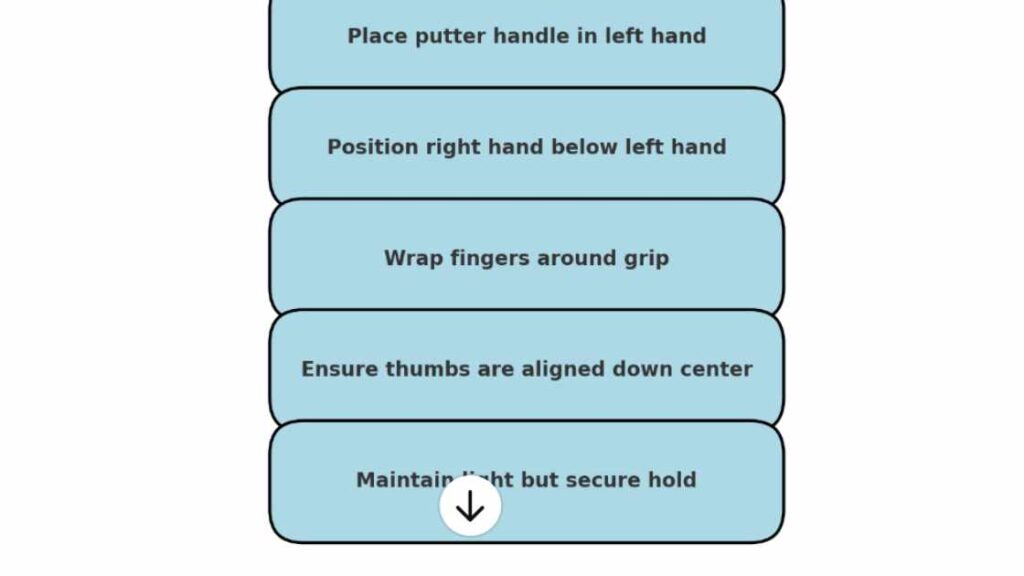
Cross-Handed Grip
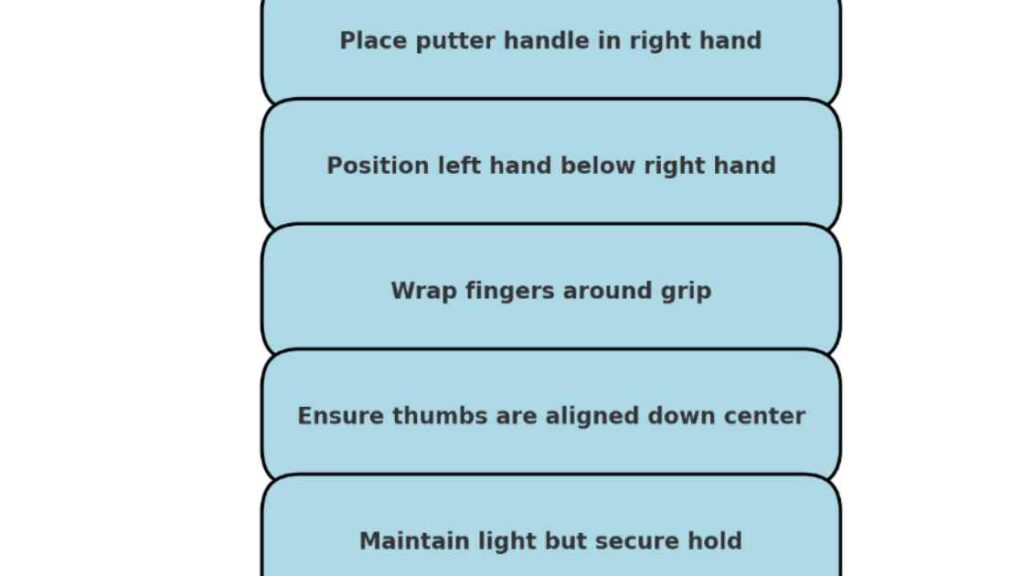
Claw Grip
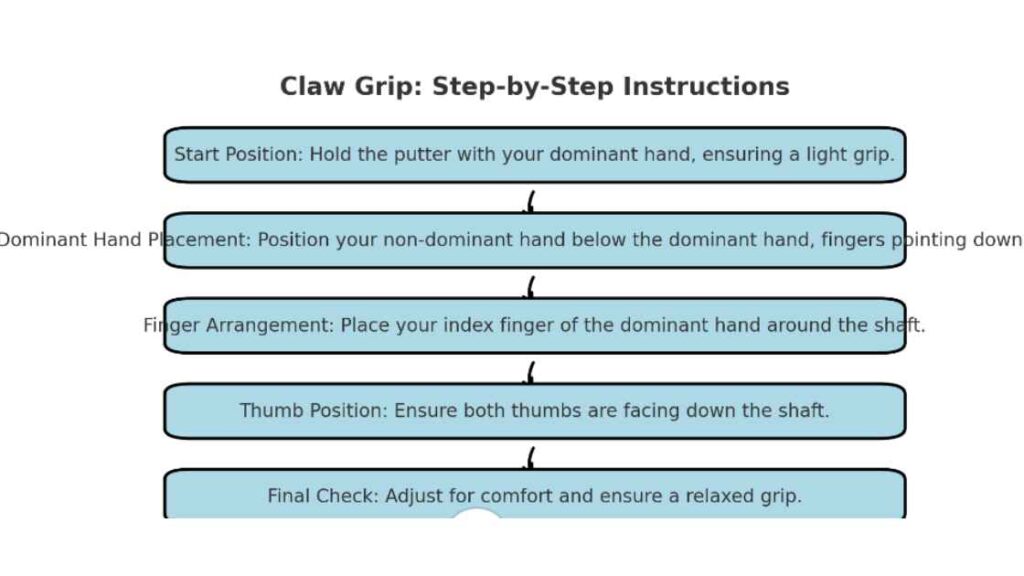
Arm Lock Grip

Reverse Overlap Grip
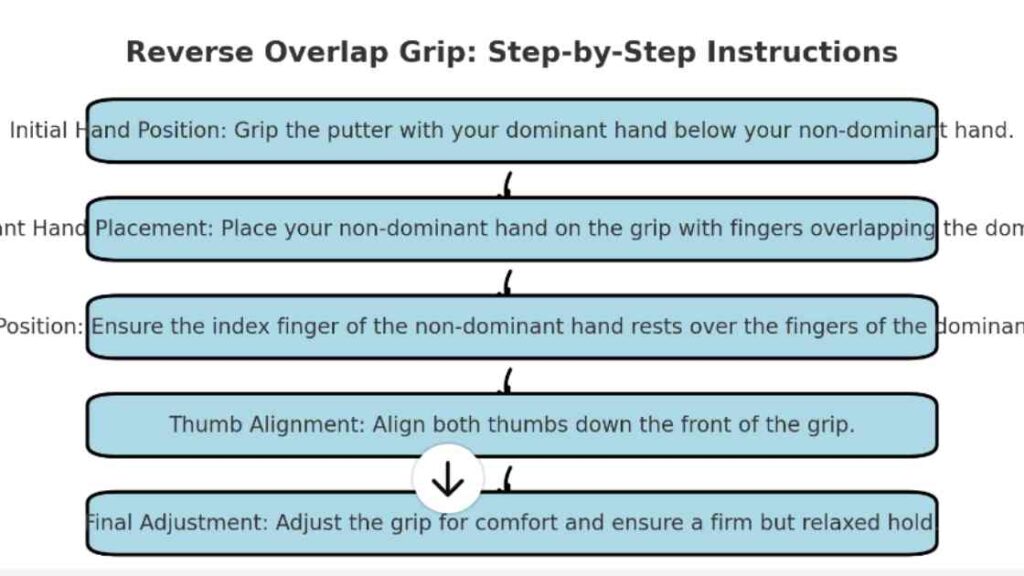
Analyzing Grip Pressure
Why Grip Pressure Matters
- Consistency: Proper grip pressure ensures consistent putting strokes.
- Control: Helps in controlling the direction and speed of the putt.
- Feel: Provides better feel and feedback from the putter to the golfer.
- Fatigue: Reduces hand and arm fatigue over the course of a round.
How to Measure Grip Pressure
- Light Grip: Hold the putter lightly, similar to holding a tube of toothpaste without squeezing out any paste.
- Pressure Scale: Use a scale of 1 to 10, where 1 is very light and 10 is very tight. Aim for a 4 or 5.
- Practice Drills: Perform drills focusing on maintaining a consistent grip pressure.
- Feedback Tools: Utilize tools like grip pressure sensors or training aids.
- Observation: Notice if your grip changes during different types of putts and adjust accordingly.
- Relaxation Techniques: Practice relaxation techniques to keep your grip pressure steady under pressure.
Ideal grip pressure range for putter grips
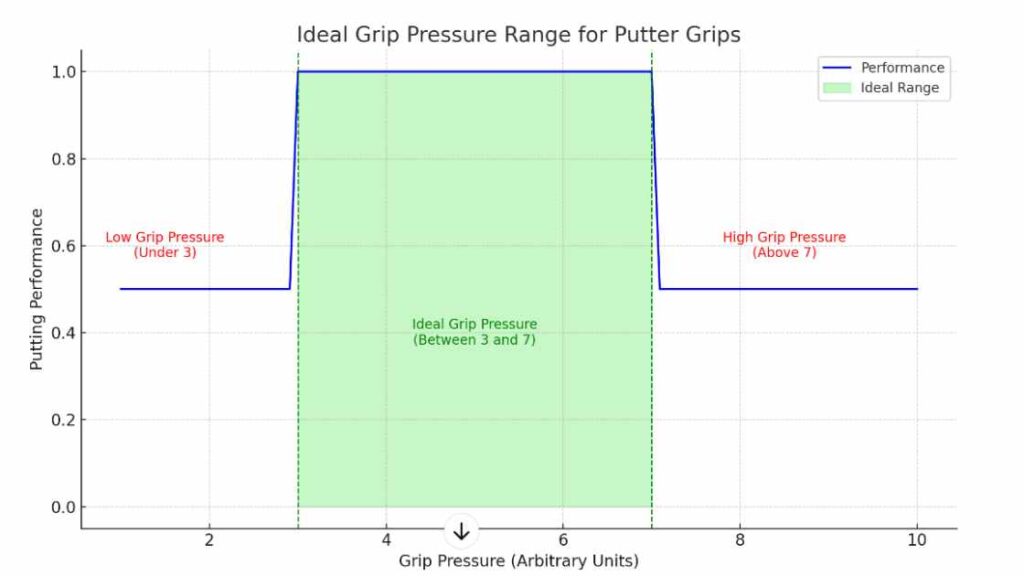
Adjusting Your Grip for Different Conditions
When it comes to putting, adjusting your grip for different conditions is crucial for maintaining control and precision. Here’s how you can adapt your grip based on various scenarios:
Weather Conditions: How to Adapt Your Grip
Wet Conditions
Use a firmer grip to prevent the putter from slipping.
Consider using gloves designed for wet weather to maintain better control.
Hot and Humid Conditions
Your hands may become sweaty, so use a slightly firmer grip to ensure stability.
Carry a towel to keep your hands and grip dry.
Cold Conditions
Hands can become stiff, so a slightly looser grip can help maintain feel.
Use winter golf gloves to keep hands warm and enhance grip.
Windy Conditions
Use a firmer grip to maintain control against gusts of wind.
Position your body to shield the putter and your grip from the wind.
Course Conditions: Adjusting Grip Based on Green Speed and Texture
Fast Greens
Use a lighter grip to have a more delicate touch.
Focus on a smooth, controlled stroke to avoid overshooting.
Slow Greens
Use a firmer grip to ensure a solid contact and push through the ball.
Make a more assertive stroke to get the ball rolling effectively.
Bumpy or Rough Greens:
Use a balanced grip, not too firm or too loose, to maintain control and adapt to the unpredictable surface.
Focus on a steady, smooth stroke to navigate bumps.
Uphill or Downhill Putts:
Uphill: Use a firmer grip to generate the necessary power.
Downhill: Use a lighter grip to ensure a gentle touch and avoid overshooting.
Table: Different Conditions and Recommended Grip Adjustments
| Condition | Grip Adjustment |
| Wet Conditions | Firmer grip; use wet weather gloves |
| Hot and Humid Conditions | Slightly firmer grip; keep hands and grip dry |
| Cold Conditions | Slightly looser grip; use winter gloves |
| Windy Conditions | Firmer grip; shield grip from wind |
| Fast Greens | Lighter grip; smooth, controlled stroke |
| Slow Greens | Firmer grip; assertive stroke |
| Bumpy or Rough Greens | Balanced grip; steady, smooth stroke |
| Uphill Putts | Firmer grip to generate power |
| Downhill Putts | Lighter grip for gentle touch |
Common Grip Problems and Fixes
Problem: Too Much Grip Pressure
Issue: If You grip the putter too tightly, causing tension in the hands and arms. This tension can lead to a jerky, inconsistent stroke.
Fix: To lighten your grip, try the following techniques:
- Hold the putter like a bird: Imagine you’re holding a bird in your hands—firm enough so it doesn’t fly away but gentle enough not to hurt it. This mental image helps maintain a relaxed grip.
- Finger pressure: Focus on applying equal pressure with your fingers rather than squeezing with your palms. This reduces overall tension and promotes a smoother stroke.
Problem: Inconsistent Grip
Issue: An inconsistent grip leads to variability in your putting stroke, making it difficult to develop a reliable and repeatable motion.
Fix: Develop a consistent grip with these drills:
- Mark your grip: Use a marker to draw lines or dots on your grip to indicate where your fingers should go. This visual aid ensures your hands are placed in the same position every time.
- Practice with a mirror: Stand in front of a mirror and check your grip setup. Repeating this drill reinforces muscle memory and helps you form a consistent grip.
Problem: Improper Hand Placement
Issue: Incorrect hand placement can result in poor control and accuracy. Common errors include one hand being too high or the hands being misaligned.
Fix: Correct hand positioning with these steps:
- Align your thumbs: Place both thumbs down the flat part of the grip. This ensures that your hands are working together and not fighting each other.
- Neutral hand position: Make sure your hands are placed in a neutral position, with neither hand dominating the grip. This balanced positioning aids in achieving a straight and smooth stroke.
Practicing Your Putter Grip
Grip Drills and Exercises
Improving your putter grip starts with specific drills and exercises. One effective drill is the “mirror drill.” Stand in front of a mirror and practice gripping the putter, ensuring your hands are in the correct position. This visual feedback helps you understand how your grip should look and feel.
Another useful exercise is the “coin drill.” Place a coin on the back of your lead hand and grip the putter. The goal is to keep the coin in place during your stroke, promoting a steady and consistent grip pressure.
Additionally, the “grip pressure drill” can enhance your control. Grip the putter lightly, around a 3 on a scale of 1 to 10, and make several practice strokes. Gradually increase the pressure to a 5, then a 7, and finally return to a 3. This drill helps you find the optimal grip pressure for a smooth, controlled stroke.
Routine Practice Tips
Developing a consistent practice routine is key to mastering your putting grip. Start each session with a few minutes of grip-focused drills to reinforce proper technique. Consistency is crucial, so try to practice at the same time each day.
Incorporate variety into your routine to maintain engagement and challenge yourself. Use different drills, such as the “mirror drill” and “coin drill,” to address various aspects of your grip.
It’s also beneficial to practice under pressure. Set up a series of putts with increasing difficulty and keep track of your progress. This not only improves your grip but also builds confidence.
Review your grip periodically. Even seasoned golfers can develop bad habits over time. Regular self-assessment ensures that your grip remains effective and consistent, leading to better putting performance.
Expert Tips and Insights
Professional Golfers’ Advice
Gripping a putter correctly is crucial for maintaining control and accuracy on the green. Professional golfers emphasize a few key tips to perfect this grip.
First, the grip should be light yet firm, akin to holding a delicate bird—you don’t want to squeeze too tightly, which can cause tension in your hands and arms. Many pros suggest aligning the lifeline of your top hand (left hand for right-handed golfers) with the grip’s top edge. This ensures the putter face stays square through the stroke.
Phil Mickelson advises players to experiment with different grips to find what feels most natural. Some common options include the traditional grip, the cross-handed grip, and the claw grip.
Rory McIlroy stresses the importance of the grip pressure remaining consistent throughout the stroke. He suggests practicing with a light grip to ensure you aren’t unintentionally tightening your hold during your swing.
FAQs
Should my hands be close together on the putter grip?
Yes, keeping your hands close together helps maintain a unified and controlled movement. This minimizes independent hand action that can lead to inconsistent putts.
Is it okay to use a thick putter grip?
Absolutely. Many golfers, including pros, use thicker grips to reduce wrist action and enhance stroke stability.
How do I know if my grip pressure is correct?
Your grip pressure should be light enough to maintain fluidity but firm enough to control the putter. A good test is to hold the putter and wiggle it gently—if it feels secure but not rigid, you’ve got it right.
Conclusion
Mastering how to grip a putter is key to improving your putting game. We’ve covered the essentials to ensure you have a solid grip. Remember, finding the right grip is about comfort and control.
Whether you prefer a traditional, cross-handed, or claw grip, the main goal is to keep your wrists steady and your strokes consistent. Practice regularly to build confidence and muscle memory.
By focusing on how to grip a putter, you’ll see a noticeable difference in your putting accuracy and consistency. So, grab your putter, experiment with these tips, and watch your putting game improve.

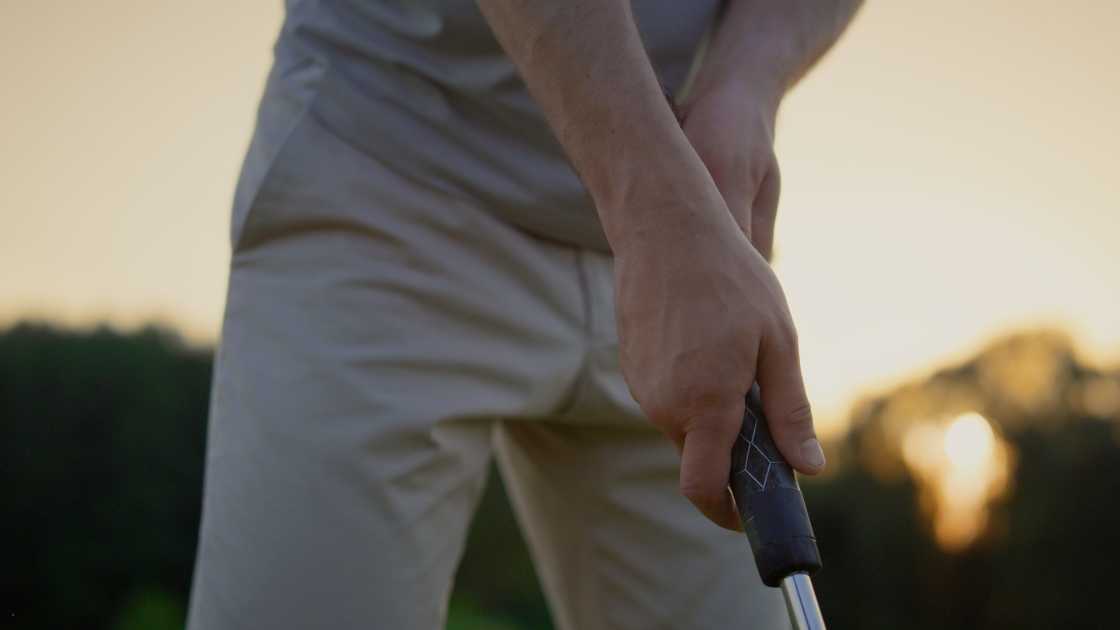








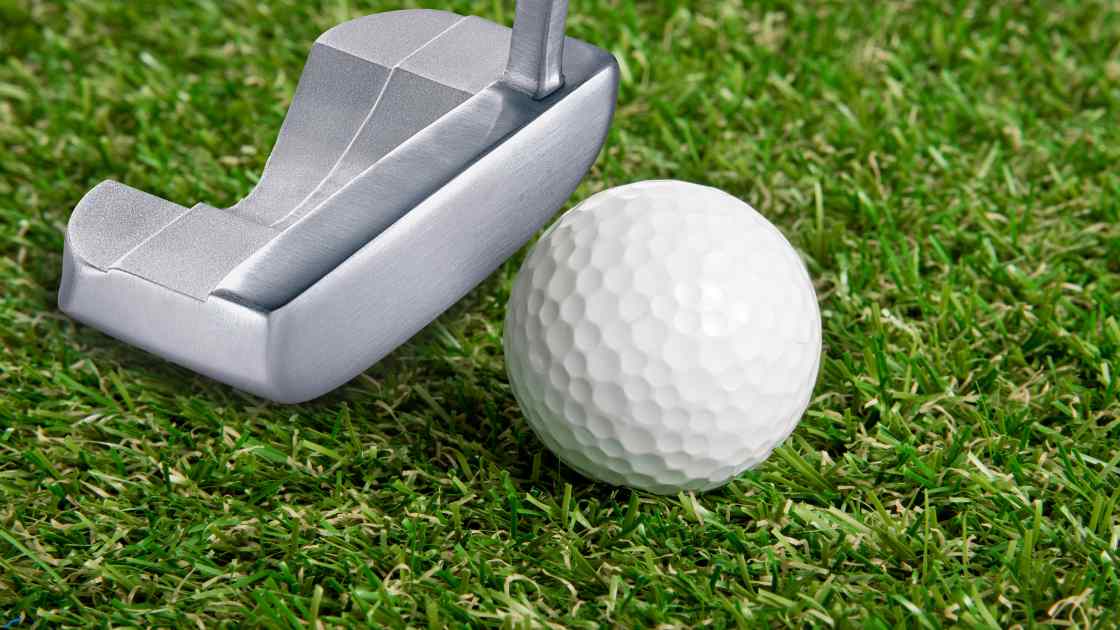


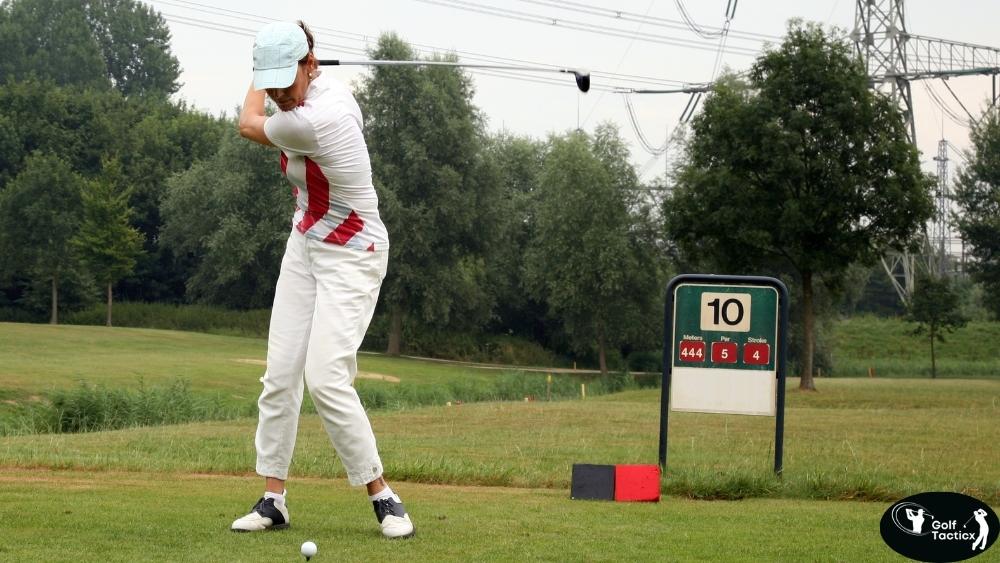


Leave a Reply